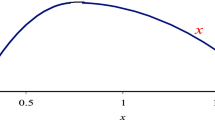Abstract
In this paper, an unambiguous graphical interpretation of fully fuzzy linear equation in two variables where all the parameters are symmetric triangular fuzzy number (STFN) is presented. Several new terminologies such as disassembled fuzzy straight line and assembled fuzzy straight line are proposed and theorems concerning those are established. This interpretation is extended to \(2\times 2\) fully fuzzy linear system (FFLS) with STFN which enables to comment on the existence of solution of the system. Then an application of FFLS is focused in a real-life circuit analysis problem where the solving procedure using available method in the literature leads to weak solution. Why this happens is explained using the proposed geometrical interpretation. Finally, a modification to the definition of TFN is proposed to manage the situation easily where weak solution arises.













Similar content being viewed by others
References
Abbasbandy S, Hashemi MS (2012) Solving fully fuzzy linear systems by using implicit Gauss–Cholesky algorithm. Comput Math Model 23(1):107–124
Allahviranloo T, Ghanbari M, Hosseinzadeh AA, Haghi E, Nuraei R (2011) A note on ‘fuzzy linear systems’. Fuzzy Sets Syst 177:87–92
Allahviranloo T, Salahshour S, Homayoun-nejad M, Baleanu D (2013) General solutions of fully fuzzy linear systems. Abstr Appl Anal 2013:1–9
Bhiwani RJ, Patre BM (2009) Solving first order fuzzy equations: a modal interval approach. In: ICETET’09, 2nd International conference on emerging trends in engineering and technology, Maharashtra. IEEE computer society, Washington DC, USA, pp 953–956
Buckley JJ (1992) Solving fuzzy equations. Fuzzy Sets Syst 50:1–14
Buckley JJ, Eslami E, Hayashi Y (1997) Solving fuzzy equation using neural nets. Fuzzy Sets Syst 86:271–278
Buckley JJ, Qu Y (1990) Solving linear and quadratic fuzzy equations. Fuzzy Sets Syst 38:43–59
Buckley JJ, Qu Y (1991) Solving systems of linear fuzzy equations. Fuzzy Sets Syst 43:33–43
Das S, Chakraverty S (2012) Numerical solution of interval and fuzzy system of linear equations. Appl Appl Math 7:334–356
Dehghan M, Hashemi B (2006) Solution of the fully fuzzy linear system using the decomposition procedure. Appl Math Comput 182:1568–1580
Dehghan M, Hashemi B, Ghatee M (2006) Computational methods for solving fully fuzzy linear systems. Appl Math Comput 179:328–343
Dubey D, Chandra S, Mehra A (2012) Fuzzy linear programming under interval uncertainty based on IFS representation. Fuzzy Sets Syst 188(1):68–87
Dubois D, Prade H (1978) Operations on fuzzy numbers. Int J Syst Sci 9:13–26
Dubois D, Prade H (1980a) Fuzzy sets and systems: theory and applications. Academic Press, New York
Dubois D, Prade H (1980b) Systems of linear fuzzy constraints. Int J Fuzzy Sets Syst 3:37–38
Ezzati R, Khorram E, Enayati R (2015) A new algorithm to solve fully fuzzy linear programming problems using the MOLP problem. Appl Math Model 39(12):3183–3193
Fan YR, Huang GH, Yang AL (2013) Generalized fuzzy linear programming for decision making under uncertainty: feasibility of fuzzy solutions and solving approach. Inf Sci 241:12–27
Friedman M, Ming M, Kandel A (1998) Fuzzy linear systems. Fuzzy Sets Syst 96:201–209
Gaichetti RE, Young RE (1997) A parametric representation of fuzzy numbers and their arithmetic operators. Fuzzy Sets Syst 91:185–202
Kaufmann A, Gupta MM (1985) Introduction to fuzzy arithmetic: theory and applications. Van Nostrand Reinhold Company Inc., New York, pp 1–43
Klir GJ, Yuan B (1997) Fuzzy sets and fuzzy logic: theory and applications. Prentice-Hall of India Private Limited, New Delhi
Kumar A, Kaur J, Singh P (2011) A new method for solving fully fuzzy linear programming problems. Appl Math Model 35(2):817–823
Lodwick WA, Dubois D (2015) Interval linear systems as a necessary step in fuzzy linear systems. Fuzzy Sets Syst 281:227–251
Malkawi G, Ahmad N, Ibrahim H, Albayari DJ (2015) A note on ‘solving fully fuzzy linear systems by using implicit Gauss–Cholesky algorithm’. Comput Math Model 26(4):585–592
Najafi HS, Edalatpanah SA (2013) A note on “a new method for solving fully fuzzy linear programming problems”. Appl Math Model 37(14–15):7865–7867
Paksoy T, Pehlivan NY (2012) A fuzzy linear programming model for the optimization of multi-stage supply chain networks with triangular and trapezoidal membership functions. J Frankl Inst 349(1):93–109
Rahgooy T, Yazdi HS, Monsefi R (2009) Fuzzy complex system of linear equations applied to circuit analysis. Int J Comput Electr Eng 1:535–541
Zadeh LA (1965) Fuzzy Sets. Inf Control 8:338–353
Author information
Authors and Affiliations
Corresponding author
Ethics declarations
Conflict of interest
Md. Mijanur Rahman declares that he has no conflict of interest. G. M. Ashikur Rahman declares that he has no conflict of interest.
Ethical approval
This article does not contain any studies with human participants or animals performed by any of the authors.
Additional information
Communicated by V. Loia.
Rights and permissions
About this article
Cite this article
Rahman, M.M., Rahman, G.M.A. Graphical visualization of FFLS to explain the existence of solution and weak solution in circuit analysis. Soft Comput 21, 6393–6405 (2017). https://doi.org/10.1007/s00500-016-2197-8
Published:
Issue Date:
DOI: https://doi.org/10.1007/s00500-016-2197-8




